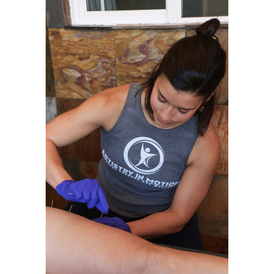Dry needling is a modern technique utilized by physical therapists, chiropractors, and other healthcare professionals to decrease pain and improve movement patterns.
How does it work?
During dry needling, a solid filiform needle is used to penetrate skin and underlying tissues without injecting any substances. The needles used are very thin - much thinner than those used when you get a flu shot or draw blood. The needles are solid with a rounded tip, so they slide through the skin and around structures in your body, rather than cutting through structures. Needles may be inserted into specific irritated muscles, or into segments around the spine that stimulate nerves in certain muscles.
Is this like acupuncture?
Although dry needling may sound a lot like acupuncture, the only real similarity is the tool (needle) used. During acupuncture, needles are applied along specific acupoints and meridians in the body to balance forces that produce the body’s Qi (chi). During dry needling, needles are applied to specific tissues causing neural or muscular dysfunction and are based on the clinician’s assessment and the client’s movement dysfunctions. Training for acupuncture and dry needling is separate, although some healthcare providers may practice both acupuncture and dry needling.
What should I expect during a dry needling session?
The exact techniques used will depend on your provider and their assessment, but can involve anywhere from one to ten (or more) needles, and may involve different techniques such as pistoning or use of electrical stimulation. Dry needling is sometimes painless since the needles are so small, but sometimes can feel like a deep, cramping sensation. You may also experience twitches in the muscle if it’s irritated.
What should I do after?
After a dry needling session, you may experience some soreness, as if you just did a really tough workout, which may last 1-2 days. The best thing to do to help with soreness is to keep your body moving! You may also use ice or heat if it feels good. A small percentage of people may notice a bruise after dry needling, but oftentimes, you won’t even be able to see where the needle was.
Dry needling is a great technique that can help with a variety of conditions and movement dysfunctions. If you are interested in learning more, or are currently dealing with a nagging pain or injury, click HERE to schedule a 1:1 visit with a Doctor of Physical Therapy to get you back to living and moving pain-free!
Thanks for reading!
Dr. Chrissy PT, DPT
Is this like acupuncture?
Although dry needling may sound a lot like acupuncture, the only real similarity is the tool (needle) used. During acupuncture, needles are applied along specific acupoints and meridians in the body to balance forces that produce the body’s Qi (chi). During dry needling, needles are applied to specific tissues causing neural or muscular dysfunction and are based on the clinician’s assessment and the client’s movement dysfunctions. Training for acupuncture and dry needling is separate, although some healthcare providers may practice both acupuncture and dry needling.
What should I expect during a dry needling session?
The exact techniques used will depend on your provider and their assessment, but can involve anywhere from one to ten (or more) needles, and may involve different techniques such as pistoning or use of electrical stimulation. Dry needling is sometimes painless since the needles are so small, but sometimes can feel like a deep, cramping sensation. You may also experience twitches in the muscle if it’s irritated.
What should I do after?
After a dry needling session, you may experience some soreness, as if you just did a really tough workout, which may last 1-2 days. The best thing to do to help with soreness is to keep your body moving! You may also use ice or heat if it feels good. A small percentage of people may notice a bruise after dry needling, but oftentimes, you won’t even be able to see where the needle was.
Dry needling is a great technique that can help with a variety of conditions and movement dysfunctions. If you are interested in learning more, or are currently dealing with a nagging pain or injury, click HERE to schedule a 1:1 visit with a Doctor of Physical Therapy to get you back to living and moving pain-free!
Thanks for reading!
Dr. Chrissy PT, DPT



